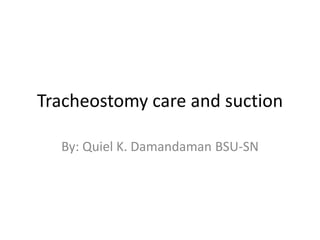
Tracheostomy care and suction
- 1. Tracheostomy care and suction By: Quiel K. Damandaman BSU-SN
- 2. TRACHEOSTOMY CARE and tracheal suctioning are high-risk procedures. To avoid poor outcomes, nurses who perform them—whether they’re seasoned veterans or novices—must adhere to evidence-based guidelines. In fact, experienced nurses may overestimate their own trach care competence.
- 3. Tracheostomy patients aren’t seen only in intensive care units. As patients with more complex conditions are admitted to hospitals, an increasing number are being housed on general nursing units.
- 4. Trach patients are at high risk for airway obstruction, impaired ventilation, and infection as well as other lethal complications. Skilled bedside nursing care can prevent these complications.
- 5. Suctioning a trach tube • assessment • oxygenation management • use of correct suction pressure • liquefying secretions • using the proper-size suction • catheter and insertion distance • appropriate patient positioning • evaluation. • Also, be sure to keep emergency equipment nearby.
- 6. Emergency preparation starts during the shift- change safety huddle—the formal communication between outgoing and oncoming shifts. Patients with trach tubes can’t call for assistance verbally, so all staff members (including the unit secretary) need to know which patients on the unit have trach tubes. Keep the following emergency equipment at the bedside of trach patients: • manual ventilator bag • two extra trach tubes—one of the patient’s current size and a smaller one • an obturator of the correct size • suctioning device and catheters
- 7. When to suction • Suctioning is done only for patients who can’t clear their own airways • Its timing should be tailored to each patient rather than performed on a set schedule. • Start with a complete assessment. Findings that suggest the need for suctioning include: • increased work of breathing • changes in respiratory rate • decreased oxygen saturation • copious secretions, wheezing, and
- 8. • the patient’s unsuccessful attempts to clear secretions. (According to one researcher, fine crackles in the lung bases indicate excessive fluid in the lungs, and wheezing patients should be assessed for a history of asthma and allergies.)
- 9. Suctioning technique 1. Before suctioning, hyperoxygenate the patient. Ask a spontaneously breathing patient to take two to three deep breaths; then administer four to six compressions with a manual ventilator bag. With a ventilator patient, activate the hyperoxygenation button.
- 10. Liquefying secretions • The best ways to liquefy secretions are to humidify secretions and hydrate the patient. • Do not use normal saline solution (NSS) or normal saline bullets routinely to loosen tracheal secretions because this practice: - may reach only limited areas -may flush particles into the lower -respiratory tract -may lead to decreased postsuctioning oxygen saturation -increases bacterial colonization -damages bronchial surfactan
- 11. Despite the potential harm caused by NSS use, one survey found that 33% of nurses and respiratory therapists still use NSS before suctioning. Other researchers have found that inhalation of nebulized fluid also is ineffective in liquefying secretions.
- 12. Evaluation • When evaluating the patient after suctioning, assess and document physiologic and psychological responses to the procedure. • Convey your findings verbally during nurse nurse-to-nurse shift report and to the interdisciplinary team during daily rounds.
- 13. Trach site care and dressing changes • Tracheostomy dressing changes promote skin integrity and help prevent infection at the stoma site and in the respiratory system. • Typically, healthcare facilities have both formal and informal policies that address dressing changes, although no evidence suggests a particular schedule of dressing changes or specific supplies for secretion absorption must be used.
- 14. On the other hand, the evidence does show that: • secretions can cause maceration and excoriation at the site • the site should be cleaned with NSS • a skin barrier should be applied to the site after cleaning • loose fibers increase the infection risk • the trach tube should be secured at all times to prevent accidental dislodgment, using the two- personsecuring technique
- 15. 1. Start by assessing the stoma for infection and skin breakdown caused by flange pressure. 2. Then clean the stoma with a gauze square or other nonfraying material moistened with NSS. Start at the 12 o’clock position of the stoma and wipe toward the 3 o’clock position. Begin again with a new gauze square at 12 o’clock and clean toward 9 o’clock. 3. To clean the lower half of the site, start at the 3 o’clock position and clean toward 6 o’clock; then wipe from 9 o’clock to 6 o’clock, using a clean moistened gauze square for each wipe. Continue this pattern on the surrounding skin and tube flange.
- 16. Caution! Avoid using a hydrogen peroxide mixture unless the site is infected, as it can impair healing. If using it on an infected site, be sure to rinse afterward with NSS
- 17. Dressing the site At least once per shift, apply a new dressing to the stoma site to absorb secretions and insulate the skin. After applying a skin barrier, apply either a split-drain or a foam dressing. Change a wet dressing immediately
- 18. Securing the trach tube • Use cotton string ties or a Velcro holder to secure the trach tube. Velcro tends to be more comfortable than ties, which may cut into the patient’s neck; also, it’s easier to apply. • The literature overwhelmingly recommends a two-person technique when changing the securing device to prevent tube dislodgment. In the two-person technique, one person holds the trach tube in place while the other changes the securing device.